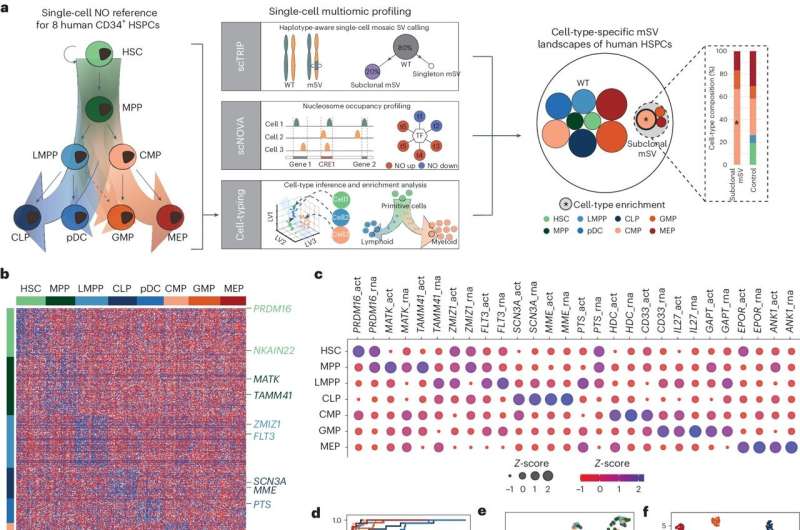This article has been reviewed according to Science X's editorial process and policies. Editors have highlighted the following attributes while ensuring the content's credibility:
fact-checked
peer-reviewed publication
trusted source
proofread
Genetic mosaicism more common than thought, study shows

Blood stem cells from healthy people carry major chromosomal alterations, suggesting we are all genetic mosaics, according to a new study from EMBL and the Max Delbrück Center.
In a study led by Jan Korbel at the European Molecular Biology Laboratory (EMBL) and Ashley Sanders at the Berlin Institute for Medical Systems Biology of the Max Delbrück Center (MDC-BIMSB), researchers have found that approximately one in 40 human bone marrow cells carry massive chromosomal alterations—copy number variations and chromosomal rearrangements, for example—without causing any apparent disease or abnormality.
In addition, cell samples from people over the age of 60 tended to have higher numbers of cells with such genomic alterations, suggesting a previously unidentified mechanism that may contribute to aging-related diseases. The study was published in the journal Nature Genetics.
"The study highlights that we are all mosaics," said Korbel, who is Senior Scientist in the Genome Biology Unit and Head of Data Science at EMBL Heidelberg. "Even so-called normal cells carry all sorts of genetic mutations. Ultimately, this means that there are more genetic differences between individual cells in our bodies than between different human beings."
Both Korbel and Sanders, Group Leader at the Max Delbrück Center study how genetic structural variation—deletions, duplications, inversions, and translocations of large sections of the human genome—contributes to the development of disease.
In the cancer field, it is well known that genetic mutations can cause cells to grow out of control and lead to the formation of a tumor, explained Sanders. "We are applying similar concepts to understand how non-cancerous diseases develop," she added.
The discovery was enabled by a single-cell sequencing technology called Strand-seq, a unique DNA sequencing technique that can reveal subtle details of genomes in single cells that are too difficult to detect with other methods. Sanders is a pioneer in the development of this technology. As part of her doctoral research, she helped develop the Strand-seq protocol, which she later honed with colleagues while working as a postdoctoral fellow in Korbel's lab.
Strand-seq enables researchers to detect structural variants in individual cells with better precision and resolution than any other sequencing technology allows, Sanders said. The technology has ushered in an entirely new understanding of genetic mutations and is now being widely used to characterize genomes and to help translate findings into clinical research.
"We are just recognizing that contrary to what we learned in textbooks, every cell in our body doesn't have the exact same DNA," she said.
Genetic mosaicism is common
The study represents the first time anyone has used Strand-seq technology to study mutations in the DNA of healthy people. The researchers included biological samples from a range of age groups—from newborn to 92-years-old—and found mutations in blood stem cells, which are located in the bone marrow, in 84% of the study participants, indicating that large genetic mutations are very common.
"It's just amazing how much heterogeneity there is in our genomes that has gone undetected so far," said Sanders. "What this means in terms of how we define normal human aging and how this can impact the types of diseases we get is really an important question for the field."
The study also found that in people over the age of 60, bone marrow cells carrying genetic alterations tended to be more abundant, with populations of specific genetic variants, or sub-clones, more common than others. The frequent presence of these sub-clones suggests a possible connection to aging.
But whether the mechanisms that keep sub-clones from proliferating in check break down as we age, or whether the expansion of sub-clones itself contributes to diseases of aging is not known, said Korbel. "In the future, our single cell studies should give us clearer insights into how these mutations that previously went unnoticed affect our health and potentially contribute to how we age."
More information: Karen Grimes et al, Cell-type-specific consequences of mosaic structural variants in hematopoietic stem and progenitor cells, Nature Genetics (2024). DOI: 10.1038/s41588-024-01754-2

















